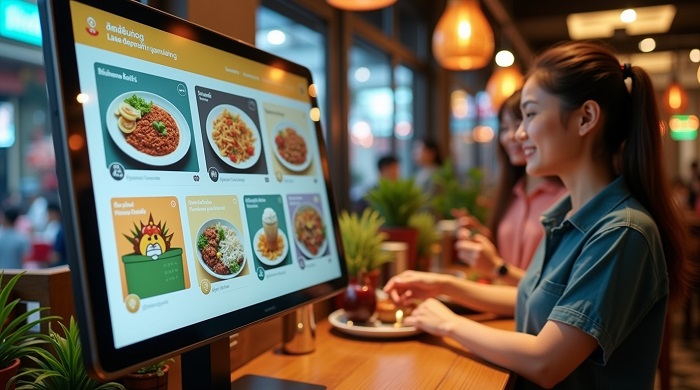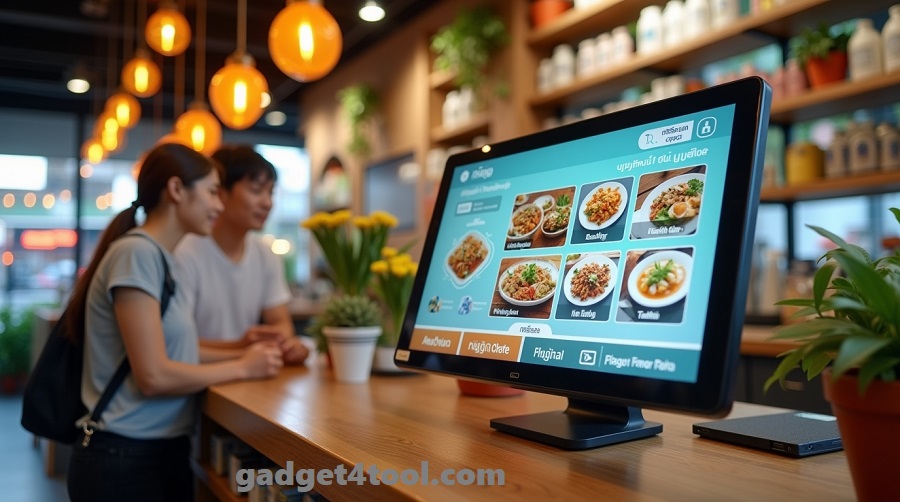Introduction: The Rise of Self-Ordering Systems in Thailand
Over the past decade, Thailand has experienced a remarkable transformation in the way businesses interact with customers. One of the most noticeable shifts is the adoption of self-ordering systems (ระบบสั่งออเดอร์สินค้าด้วยตนเองในประเทศไทย) in restaurants, cafes, supermarkets, and retail stores. This innovation is not just about replacing cashiers with machines; it represents a broader movement toward automation, digital convenience, and enhanced customer satisfaction. Thai consumers are becoming increasingly comfortable with using kiosks, tablets, and mobile applications to place their own orders without waiting for staff. Businesses across the country from global fast-food giants in Bangkok to small local eateries in Chiang Mai are seeing the benefits of this technology.
In this article, we will explore the development of self-ordering systems in Thailand, their impact on both businesses and customers, challenges faced during implementation, future trends, and why they are becoming an essential part of modern Thai commerce.
What is a Self Ordering System?
A self ordering system is a digital solution that allows customers to independently browse menus, select products or services, customize options, and complete purchases without direct assistance from staff. These systems can take different forms, such as:
- Self-service kiosks with touchscreen interfaces often placed inside restaurants or shopping centers.
- Tablet-based ordering systems where customers use devices provided on each table.
- Mobile ordering applications integrated with digital payments, delivery, or pickup options.
- QR code ordering where customers scan a code on their table or menu and complete the transaction via their smartphone.
In Thailand, the concept of self ordering systems aligns perfectly with the country’s growing digital economy and rising consumer expectations for speed and convenience.
The Evolution of Self-Ordering Systems in Thailand
Thailand’s journey toward self-ordering began with international fast-food chains like McDonald’s, KFC, and Burger King, which introduced self-service kiosks in urban areas. Soon after, local restaurant chains and cafes started to adopt similar technology, realizing that it not only reduces waiting times but also improves order accuracy.
The COVID-19 pandemic further accelerated this trend. With restrictions on physical contact and a heightened awareness of hygiene, many Thai businesses quickly invested in contactless ordering systems. QR code menus became the norm, and mobile applications gained popularity across the food and beverage industry.
Today, even traditional Thai eateries and street food vendors are experimenting with digital ordering platforms, showing how far the technology has penetrated into everyday life.

Why Businesses in Thailand Are Adopting Self-Ordering Systems
1. Improved Customer Experience
Thai customers value convenience. With a self-ordering system, they can browse menus at their own pace, explore combo offers, and customize orders without feeling rushed. This creates a smoother and more satisfying dining or shopping experience.
2. Increased Efficiency and Speed
For restaurants and retail outlets, handling peak hours can be challenging. Self-ordering kiosks and mobile apps help reduce long queues by allowing multiple customers to place orders simultaneously. Staff can then focus on preparing food or managing inventory instead of taking orders.
3. Higher Revenue and Upselling Opportunities
Digital systems can be programmed to suggest add-ons, upsell products, or highlight promotional items. For example, when a customer orders a Thai iced tea, the kiosk might suggest a dessert combo. This automation leads to higher sales compared to traditional ordering methods.
4. Labor Cost Reduction
In Thailand, where labor costs are relatively affordable compared to Western countries, reducing staff might not be the primary motivation. However, reallocating staff from repetitive tasks like order-taking to customer service roles adds greater value to the business.
5. Contactless and Hygienic Solutions
Especially post-pandemic, contactless ordering has become a key selling point. Customers in Thailand are now more health-conscious, preferring minimal physical interaction during transactions.
Consumer Behavior in Thailand Toward Self-Ordering Systems
Thai consumers are highly adaptive when it comes to new technology. With the majority of the population using smartphones and being active on mobile banking applications like PromptPay, TrueMoney Wallet, and LINE Pay, shifting to digital self-ordering feels natural.
However, generational differences exist. Younger customers, particularly millennials and Gen Z, embrace kiosks and mobile ordering apps enthusiastically. Older generations may still prefer traditional face-to-face service, but gradual exposure is increasing acceptance across all age groups.
Types of Self-Ordering Systems Popular in Thailand
Self-Service Kiosks
Found in malls, cinemas, and quick-service restaurants. These kiosks allow customers to make selections quickly and pay using credit cards, mobile wallets, or QR codes.
QR Code Ordering
A favorite among Thai cafes and casual dining spots. Customers simply scan a QR code on the table, access the menu online, place their order, and pay digitally.
Mobile Ordering Apps
Brands like Starbucks Thailand and food delivery giants such as GrabFood and Foodpanda have familiarized Thai customers with app-based ordering. Many restaurants are now creating their own branded apps.
Tabletop Tablets
Some mid-to-high-end restaurants install tablets at each table for customers to order food, request service, or even call for the bill.
Benefits of Self-Ordering Systems for Thai Consumers
- Convenience: No need to wait in line for staff to take the order.
- Customization: Customers can easily add or remove ingredients from dishes.
- Accuracy: Orders placed digitally reduce the chances of miscommunication.
- Faster Payment: Integration with Thai e-wallets and QR code payments simplifies checkout.
- Bilingual Options: Menus often support Thai and English, making it easier for tourists.
Challenges in Implementing Self-Ordering Systems in Thailand
High Initial Costs
Installing kiosks and developing custom mobile apps can be expensive for small Thai businesses.
Technical Maintenance
Digital systems require regular updates, troubleshooting, and repairs. Smaller businesses without IT teams may struggle.
Customer Education
While younger Thais adapt quickly, older customers may need guidance, especially in rural areas.
Connectivity Issues
Stable internet is crucial for QR code ordering and mobile apps. In some regions of Thailand, inconsistent connectivity can affect system performance.

Case Studies: Self Ordering Success in Thailand
McDonald’s Thailand
McDonald’s kiosks allow customers to place orders in both Thai and English, supporting multiple payment methods. The result has been shorter lines and smoother service in busy outlets.
Café Amazon
Thailand’s famous coffee chain has introduced mobile ordering through its app, letting customers skip queues. The app also integrates loyalty rewards, increasing customer engagement.
Local Thai Restaurants
Even small noodle shops in Bangkok have adopted QR ordering, offering both dine-in and takeaway options. This helps them manage high traffic during lunch hours efficiently.
Future of Self Ordering Systems in Thailand
The next wave of development is likely to include AI-powered recommendations, voice-enabled ordering, and deeper integration with delivery platforms. Virtual reality menus and augmented reality product previews could also enhance the customer journey. With Thailand’s strong push toward becoming a digital-first economy under initiatives like Thailand 4.0, self ordering systems will only grow in importance.
Comparison: Traditional Ordering vs Self Ordering in Thailand
| Speed | Slower during peak hours | Faster, multiple orders at once |
| Accuracy | Depends on staff memory | Highly accurate, system-based |
| Cost | More staff required | Lower staff requirement |
| Convenience | Limited customization | Full customization and upselling |
| Payment | Mostly cash/credit card | Digital wallets, QR codes, cashless |
SEO Benefits and Digital Visibility for Businesses
From an online marketing perspective, businesses that implement self ordering systems in Thailand can leverage the trend for SEO growth. Customers frequently search for terms like “ร้านอาหารสั่งออเดอร์ด้วยตนเอง” (restaurants with self ordering) or “self ordering kiosks in Bangkok.” By highlighting these features on websites and social media, businesses gain stronger visibility and attract tech-savvy customers.
Conclusion: The Future Belongs to Self Ordering
The self ordering system in Thailand (ระบบสั่งออเดอร์สินค้าด้วยตนเองในประเทศไทย) is no longer just a trend—it is a necessity in modern commerce. From fast-food chains in Bangkok to family-run cafes in Phuket, the adoption of digital ordering solutions is reshaping customer experiences and business operations. While challenges remain in cost, education, and connectivity, the benefits far outweigh the obstacles. Businesses that embrace this technology not only improve efficiency and customer satisfaction but also position themselves as forward-thinking players in Thailand’s digital economy.
As the nation continues its journey toward Thailand 4.0, self ordering systems will play a critical role in shaping the retail and food industry landscape, making every transaction faster, smoother, and more enjoyable for both locals and international visitors.
FAQs about Self Ordering Systems in Thailand
Are self ordering systems expensive to install in Thailand?
Costs vary depending on the system, but QR ordering is relatively low-cost compared to kiosks.
Can tourists use self ordering systems easily in Thailand?
Yes, most kiosks and apps offer both Thai and English interfaces.
Do self ordering systems replace human staff completely?
No, they reduce repetitive tasks, allowing staff to focus on service quality.
Which payment methods are supported in Thailand’s self ordering systems?
PromptPay, TrueMoney Wallet, LINE Pay, credit/debit cards, and cash in some cases.
Will self ordering systems continue to grow in Thailand?
Yes, the trend is expanding rapidly, fueled by digital adoption and customer demand.



